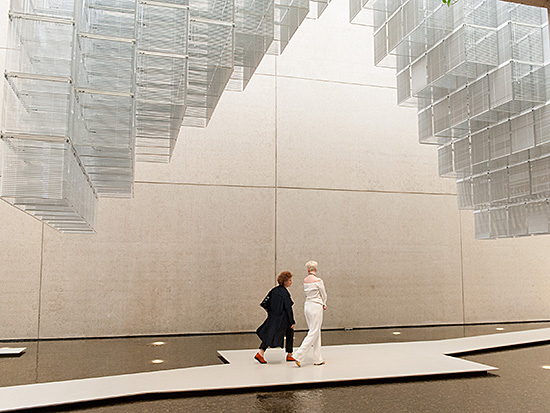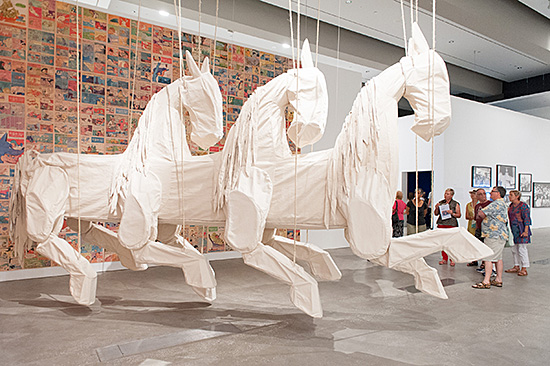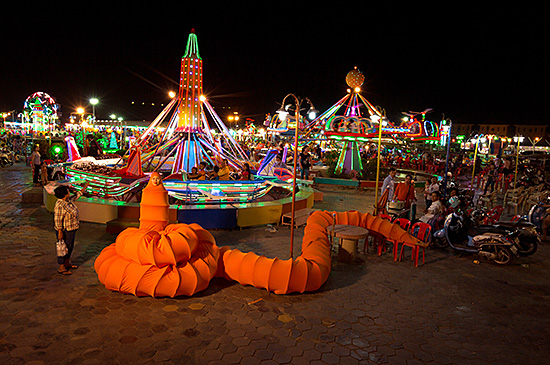December 29, 2015
‘Just Enough Critique’: the 8th Asia Pacific Triennial of Contemporary Art.
Queensland Art Gallery – Gallery of Modern Art, Brisbane
21 November 2015 – 10 April 2016
Written by Paolo Magagnoli
We live in a ‘Post-Critical’ age. So laments Hal Foster in a 2012 article on the state of critical theory in art history. Once the main domain of art, he argues, the practice of critique is now under attack and is suffering from exhaustion.[1] Foster may have a point here: as other fields of the humanities, art history too has been characterized by the widespread tendency towards the abandonment of theory in favour of empiricist and archival models of historical research that advocate for a stance of scholarly neutrality. Foster’s lament may seem overstated and excessively catastrophic. In the past five years and concomitantly with the emergence of transnational social movements such as Occupy Wall Street, a plethora of books, magazines, and exhibitions devoted to ‘social practice art’ and ‘activist art’ has emerged (this journal being just one of the manifold examples of the trend) and one could even go as far as claiming that today, what constitutes art and art museums’ legitimizing discourse is precisely the criticality of the artwork.
Paradoxically, as an unfortunate aspect of this very same current, the art exhibition sometimes ends up producing only a ‘simulacrum’ of criticism. In this article I want to explore the last Asia Pacific Triennial of Contemporary Art (APT8) in Brisbane, which I take as symptomatic of a broader tendency of contemporary art museums to superficially embrace the language of critique —an embrace that unfortunately hollows out critique’s central function: the recognition of the social and economic conditions of the institution in which art is produced and exhibited.

Grandiosely presented as the ‘world's largest exhibition of art from Australia, Asia and the Pacific’, the APT Triennial was first established in 1993 and it is spread between Brisbane’s Queensland Art Gallery (QAG) and Gallery of Modern Art (GoMA).[2] This year the APT clearly takes up the cause for social justice. One of the criteria for the selection of the artists —we read in the catalogue— is their deep concern with “the Umbrella Movement in Hong Kong, the Sunflower Movement in Taiwan, the Anti-Nuclear movement in Japan and the political turmoil in Thailand and other parts of South-East Asia.”[3] The exhibition’s intention is to “create critical spaces for art” by presenting the work of artists responding to the contemporary world, its crises and challenges, from “economic development, environmental exploitation and natural disasters” to “technology, democracy and human rights; border disputes; and the operation of the politics of nationhood.”[4] The shortcut through which the exhibition looks at the problems of the Asia-Pacific region is the figure of the body. Indeed many of the art works on display are live performances, documentations of performances, and highly-crafted large scale photographs in the directorial mode that focus on the human figure.

“This APT asks,” write the APT8 curators in the catalogue, “what makes these bodies reflective of their histories and environments?”[5] In fact, the question remains largely unanswered throughout the show: the bodies populating the space of the Triennial reflect less their socio-economic context than a desire to escape reality in search for a fantasy world of monsters, knights, drag queens, goddesses and other mythical or highly idealized figures. Consider the performance Ex Nilalang (2015) by Filipino Australian artists Bhenji Ra and Justin Shoulder: the artists came out of a lift in the museum hallway wearing floor-length flesh coloured gown and impersonating a magical figure that looked like a sci-fi Chinese dragon or an androgynous android with one white eye. Or, in a more spectacular register, Cambodian artist Anida Yoeu Ali’s The Buddhist Bug, Into The Night (2015), a big two-screen projection that shows the artist clad in a long orange and worm-shaped costumes walking through the crowded streets of Phnom Penh at night. Accelerating the film speed, Ali created the impression of a kinetically dazzling race through the city. Finally, consider the video by the Vietnamese UuDam Tran Nguyen’s Serpents' Tails (2015), a carefully choreographed dance of motor bikers wearing facemasks and protective capes (or in the curators’ words ‘anonymous knights from a forgotten myth’). The examples could be multiplied many times but these three alone point to a tendency of the art displayed in the APT8 to transcend social reality and evade the limitations and misery of exploitative labour, forced migration, and environmental destruction. This would not necessarily be a problem if it was not for the curatorial discourse that frames the art works, and which emphasizes and insists on their criticality: “Ra and Shoulder,” reads for example the wall-text, “use their bodies to forge connections between queer, migrant, spiritual and intercultural experiences”; Ali’s performance ‘explores diasporic identities’; and UuDam Tran draws attention to the toxic impact of heavy traffic in Ho Chi Minh City. Nevertheless, the tensions and conflicts of South East Asian countries are invisible. If anything, what these artistic practices reveal, in a self-delusional way, is that enormous social and economic problems can be easily solved through the magical power of art, desire, and the imagination.

The surrealist style of most of the art displayed in the APT8 contributes to the overall spectacular and entertaining effect of the exhibition. It also serves another function: by choosing works that more or less obliquely hint at the ongoing crises of the Asia-Pacific region without providing an explanation and a solution, the APT8 avoids lambasting politics and stirring controversy and maintains an apparent neutral political stance. But critique is not the equivalent of distance or political correctness. Derived from the Greek verb krinein, meaning to discern or judge, critique is a scholarly practice that demands investigation not only into the historical and social conditions of an artwork’s emergence, but also into the conditions and limits of the speaker who presumes to discuss it. In terms of curatorial and artistic practice, critique involves a reflection of the social conditions of the works’ production and exhibition and the art institution’s own relation to the neoliberal economy. Indeed this reflection is missing as none of the artists selected attempts to address this relation. In the case of the APT8 there is clearly a contradictory split between, on the one hand, the construction of the museum as a space of political contestation and resistance and, on the other, the museum’s reliance on corporate sponsors that are responsible for the same problems that are being denounced and criticized.
One example of this split can be seen in how a green politics is simultaneously embraced and disavowed by the APT8. Occupying the interior walls of GOMA’s entrance hallway, a monumental charcoal mural by the Indian artist Prabhakhar Pachpute shows the globe reduced to a sterile, apocalyptic and huge mining pit. Born and raised in Chandrapur, India, where his family has worked for three generations in one of the oldest coal mines in the country, Pachpute produces drawing and animations that are powerful statements against India’s heedless development. The decision of the curators to exhibit Pachpute’s mural in the entrance of the gallery attests to their bold critique of the relentless and dangerous extraction of natural resources —indeed one of the most pressing problems facing South East Asia as well as Australia (the federal government has just approved the project for the construction of its biggest coal mine which will have a devastating impact on the Great Barrier Reef). Yet a few steps away from Pachpute’s work there is small computer console that entices visitors to participate in a competition to win a ‘VIP Audi Art Experience’. The famous car manufacturing company —one of the corporations responsible for air pollution and climate change— is ironically the main sponsor of the event.[6]

The only glimpse of institutional critique is offered by Australian artist Richard Bell. Hidden in a small room on the second floor, Bell’s Larry (2015) and 3 x 35 (2015) are satires of the art world. The former video shows the artist impersonating the figure of a wealthy and cynical art dealer who treats the art object as pure vehicles for commercial success and narcissistic pleasure. The camera shows Bell walking in Venice during the glittering Art Biennial, standing alongside opulent yachts, and sniffing cocaine. In the second video Bell narrates his psychoanalyst, a cheeky red-hair puppet, a dream in which he is approached by the four horsemen of the Apocalypse (represented by other puppets). These buy the artist’s soul with promise of giving him magical super-powers. The film ends with the image of the artist in a long black hooded cloak cape and devil sickle, throwing lightning bolts at the Guggenheim museum in New York, the White House and Tate Modern —symbols of high art elitism and power. Bell’s jabs are highly entertaining but also clichéd and conventional, recalling the sarcasm of Banksy’s graffiti.[7] More importantly, the artist’s seemingly self-directed humour and Dada spirit works to justify viewer’s sneering sense of superiority and facile populism.
Attempting to engage with the dramatic social reality of South East Asia the APT8 creates ‘critical spaces for art’, but at the same time hollows these spaces out, reducing critique to an empty badge. “Art discourse no longer speaks of the social and psychological world as if it did not speak of it.”[8] So remarked Andrea Fraser. “It speaks of that world incessantly... And yet, it seems to me, to a very large extent, it speaks of that world so as not to speak of it, … in forms that perform a negation in a Freudian sense quite specifically.”[9] Fraser’s analysis seems valid for the APT8 as well. A kind of unconscious “negation” is at work in the way the show simultaneously invokes and denies the harsh reality of globalization and the institution’s vulnerability to neoliberal capitalism. In Fraser’s view negation is a defensive manoeuvre that allows the curator, the artist, and the spectator to forget his own complacency with the world’s social inequalities and his own sense of impotence in the face of systemic contradictions that are too hard to bear. Likewise, the APT8 epitomizes how contemporary art criticism may perform the role of providing “for just enough distance, just enough not me, just enough sense of agency, to be able to tolerate the raw shame of exposure, the fear or pain of loss, and the trauma of helplessness and subjection.”[10]
Paolo Magagnoli is a Lecturer in History of Art at the University of Queensland. He writes widely on modern and contemporary art and visual culture. He is the author of Documents of Utopia: The Politics of Experimental Documentary (Columbia University Press: 2015). His essays have been published in academic journals such as The Oxford Art Journal, Third Text, Afterall, Philosophy of Photography, Transnational Cinemas, and Academic Quarter. He is also a critic writing for international art magazines such as Camera Austria, Frieze and Art in America.
[1] Hal Foster, “Post-Critical”, October 139 (Winter 2012), p. 3.
[2] Mainly devoted to the art of South East Asia and the Pacific, the APT’s audience has been growing from sixty-thousand visitors of the first edition in 1993 to more than five hundred thousand in 2012. Likewise over the last decade the event has considerably broadened its geographical scope. The artists displayed this year come from more than eighty countries. These data are available online at: https://www.qagoma.qld.gov.au/about/our-story/apt
[3] Maud Page and Aaron Seeto, “How far can you run with the world behind you?” The 8th Asia Pacific Triennial of Contemporary Art (Brisbane: Queensland Art Gallery, 2015), p. 20.
[4] Ibid.
[5] Ibid., p. 21.
[6] The Gallery of Modern Art is an “organisation that shares our values of progressiveness and innovation”. So writes Audi’s managing director in the first pages of the APT8 exhibition catalogue. The car manufacturer’s support of the arts can be viewed as the company’s strategic attempt to incorporate social responsibility into corporate branding.
[7] Commenting on Banksy’s satire of Disneyland Dismaland, Dan Brooks has remarked: “Sarcasm is a natural fit for partisan news aggregators, because it relies on a calculated appeal to shared attitudes. Kitsch banks heavily on these shared attitudes. It substitutes them for artistic insights, and it relies on its audience’s agreement with them to produce a feeling similar to profundity.” Dan Brooks, “Banksy and the Problem of Sarcastic Art”, The New York Times, September 10 2015. On Banksy’s work see also Julian Stallabrass, “Elite Art in an Age of Populism”, in Alexander Dumbadze/ Suzanne Hudson, eds., Contemporary Art: 1989 to the Present (Oxford: John Wiley & Sons, 2013), pp. 39-49.
[8] A. Fraser, “There’s No Place Like Home,” The Whitney Biennial 2012 (New York: Whitney Museum, 2012), p. 29.
[9] Ibid., p.32.
[10] Ibid.









